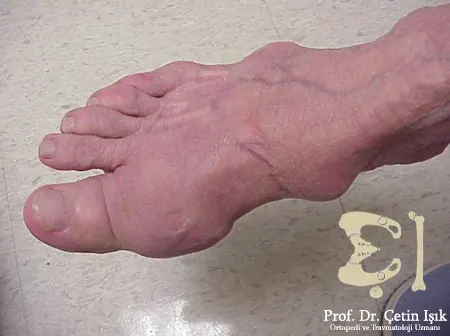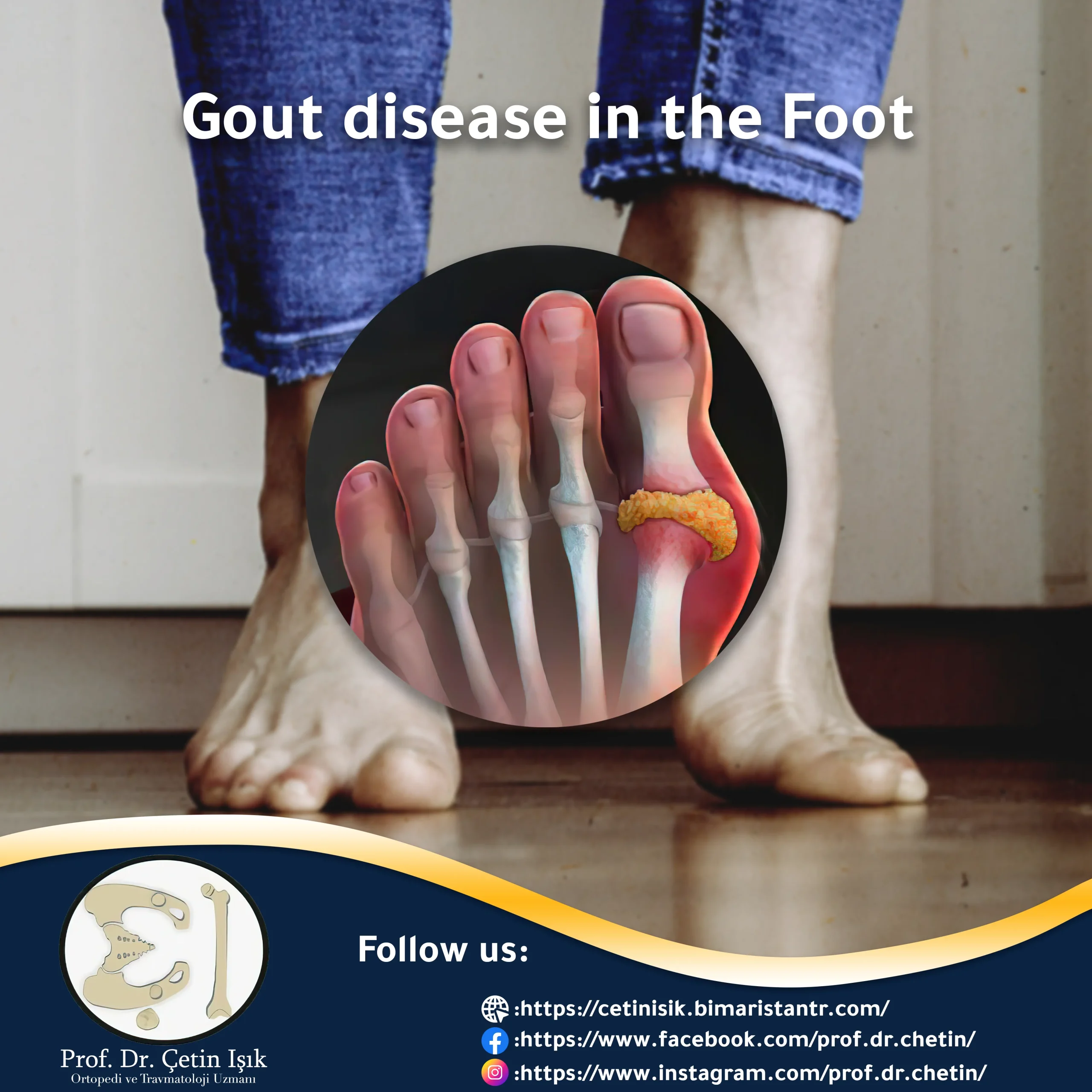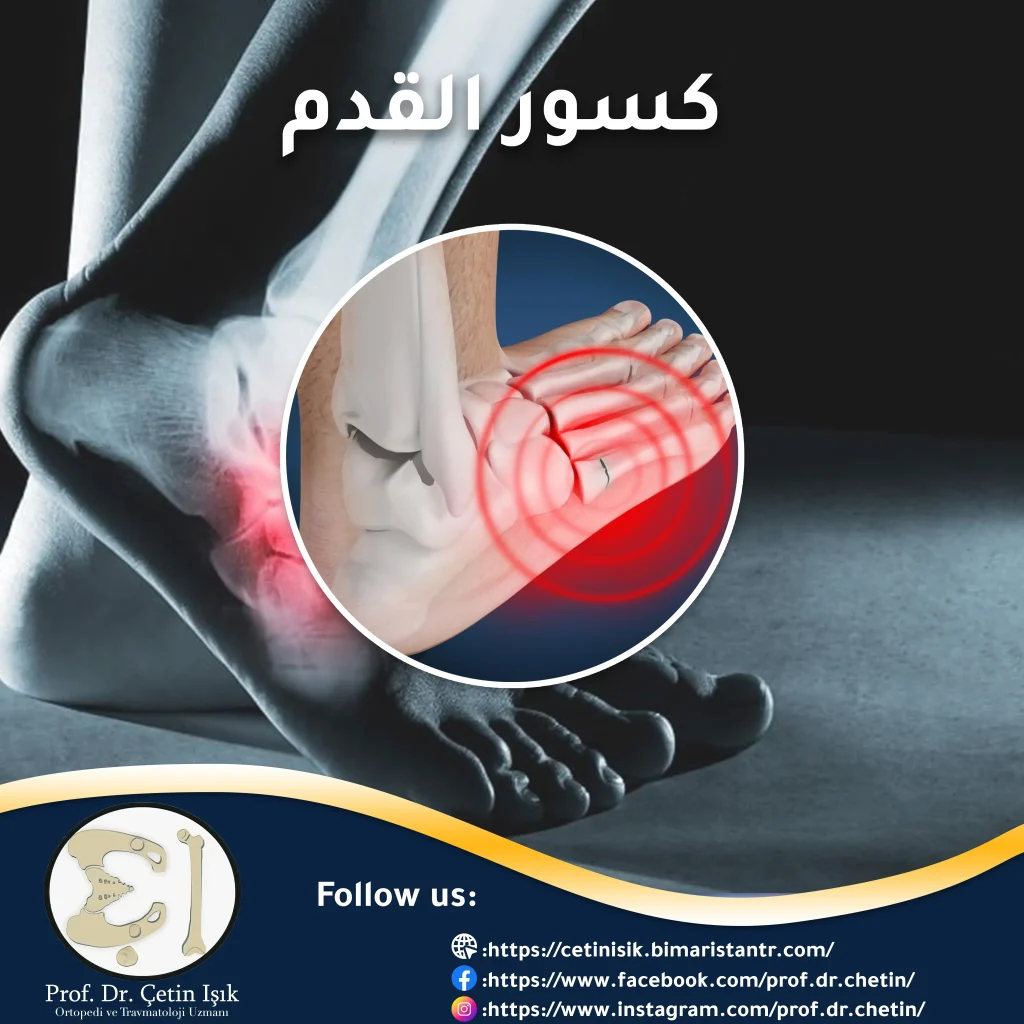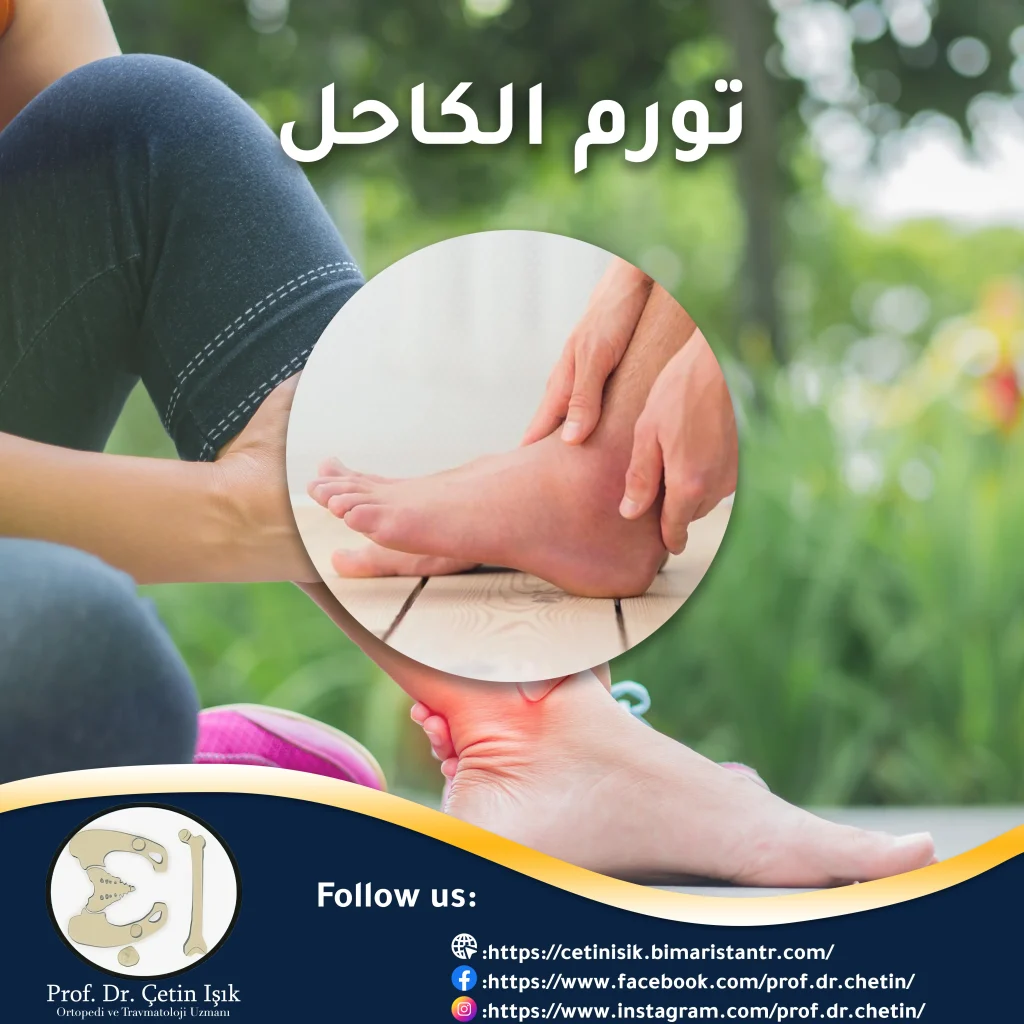Gout in the foot, also known as the disease of kings, is an inflammation of the joints as a result of the accumulation of uric acid crystals in them. After that, patients suffer from many and varied symptoms such as attacks of pain, difficulty walking, and redness of the big toe.
What is gout?
Gout in the foot is a type of arthritis that causes sudden attacks of severe swelling, pain and redness of the joint, and it usually lasts for a week or two and then goes away on its own.
Attacks appear suddenly, especially in the big toe or the joints of the feet and knees, and the cause of this problem is due to the high levels of uric acid in the blood, as this results in pointed crystals that begin to accumulate in and around the patient’s joint, and in some cases this leads to painful joint inflammation .

When the body also makes or fails to excrete enough uric acid, levels of uric acid begin to rise, but it is not always necessary that every excess leads to gout in the foot.
Structures that may develop gout include:
- The joints themselves
- Bursae of joints
- Ligaments
- The kidneys
The relationship between gout and the kidneys is a close relationship, as this disease may cause the well-known renal symptoms of colic pain, which is a feeling of severe pain in the flanks area, in addition to getting kidney stones and they affect the kidney and bladder and causes pain when urinating.
Symptoms of gout
Gout in the foot is a disease that goes through many stages, as it initially occurs in the form of:
- Excessive uric acid in the blood: Initially, gout in the foot is not accompanied by any pain, but it develops silently.
- Severe attacks: It is the episodic pain that usually alert patients with gout that there is a problem that they did not pay attention to.
- Intercritical gout Often after a severe attack the disease disappears and patients may commonly believe that they have recovered, but in fact it has turned into a chronic disease that will cause symptoms for a long time.
- Tophi: It is a late condition where crystals accumulate in the skin and many areas of the body, and depending on their location, it will lead to disastrous results, especially if they accumulate in the internal organs such as the kidneys and liver.
Gout Symptoms
The most common symptom of gout is joint pain and most patients suffer from the first attack of pain in the big toe. The attacks usually strike the joints sharply in the middle of the night, leading to awakening from sleep, in addition to the fact that the patient's joint is hot and swollen with redness.
Symptoms of gout in women
Gout in the foot is less common in women and its symptoms usually begin at a later age after menopause because female hormones regulate the level of uric acid in the blood and protect the joints from gout.
Women with gout in the foot complain of pain in the ankles when wearing high-heeled shoes, the inability to walk long distances, and redness of the toes.

Symptoms of gout in men
Because men are exposed to many types of triggers of gout in the foot, it is common at an earlier age, especially among alcoholics and obese people.
Patients experience more episodes of pain and due to neglect, the affected finger joint may become deformed and uric acid crystals accumulate in the ankle, knee and elbow with the appearance of skin tophi.
Symptoms generally get worse if:
- The pressure
- Chronic kidney disease
- Diabetes
- Obesity
- Kidney stones
- Congestive heart
- Heart attack
The most common form of gout is foot gout, but sometimes the condition affects a number of other joints less commonly.
Symptoms of gout in the knee
It includes:
- Knee swelling
- Acute pain in the knee when walking
- Change in skin color around the affected knee
- Warmness and redness of the knee
Symptoms of gout in the back
- Back pain
- Feeling of numbness greatly, especially in the back and feet
- Loss of control of the urinary and anal sphincters
Shoulder gout symptoms
It is rare for the shoulder joint to be affected with gout, but if this happens, the patient complains of pain and stiffness when moving it.
Symptoms of gout in the metatarsal and ankle
The most important joints that suffer from gout are in the foot, where the big toe and its joints are the first affected joint, followed by the second toes and ankle joints.
The following symptoms are usually seen in the feet:
- Arthralgia: It may last up to 12 hours after the onset of the attack.
- Feeling uncomfortable for a long time: After the acute pain subsides, the feeling of mild pain in the patient's joint continues for several days and may last for weeks.
- Inflammation and redness: Joints swell and become painful and hot to the touch.
- Limited range of motion: It occurs after the injury persists for several years, as the joints become stiff and lose the ability to move normally.
Causes of gout
Gout occurs when sodium urate crystals accumulate in the joints, as mentioned previously. Urate or uric acid comes from the breakdown of purines in the body and foods, and these compounds are naturally excreted in the urine.
When not sufficiently excreted, it forms crystals that cause the inflammation that occurs in gout.
Scientists are still searching for the true cause of gout and how environmental and genetic factor interact in the occurrence of gouty arthritis, and it has been agreed that there are a number of risk factors, the most important of which are:
- High levels of uric acid in the blood
- A family history of gout
- Getting old
- Drinking alcohol
- Foods rich in purines, such as meat
- Drinks high in fructose, such as soda

People with gout should avoid certain foods so that attacks do not occur frequently
There are also some diseases that increase the risk of gout, such as:
- Obesity
- Metabolic syndrome which includes hypertension, diabetes and high cholesterol.
- Chronic kidney disease.
- Psoriasis.
- Hemolytic anemia.
- Some cancers.
It should be noted that there are some medications that contribute to raising uric acid levels and the occurrence of gouty arthritis:
- diuretics
- Low doses of aspirin
- Vitamin B or niacin
- Cyclosporine which is an immunosuppressant
Causes of gout in women
In general, the incidence of gouty arthritis increases in women after menopause and the reason for this is due to low levels of estrogen, obesity and advanced age.
Gout diagnosis
It may be difficult to diagnose gout in the foot, especially when the symptoms overlap with a number of other diseases such as rheumatoid arthritis and osteoarthritis. the doctor in order to get a proper diagnosis can:
- Take the medical history in detail.
- Careful examination of the foot, especially the big toe.
- Perform laboratory tests to check the levels of uric acid in the blood.
- Sampling of articular fluid and analysis.
- Perform an ultrasound.
Methods of treating gout
Depending on the symptoms and causes of the disease, the appropriate treatment is determined for each case individually. Most treatments focus on:
- Reducing pain from attacks.
- Reduce the possibility of future attacks.
- Preventing the formation of tophi that damage joints and destroy bone tissue.
- Management of gout complications such as heart and kidney problems.
Treating gout with medication
When a gout attack occurs, the doctor may suggest taking some medications, such as NSAIDs and colchicine, which achieve the greatest benefit at the beginning of the infection and are less effective later.
If the symptoms of gout are more severe, corticosteroids are prescribed orally or by direct injection into the affected foot joint, and urea acid-reducing drugs are given with it, including:
- Xanthine oxidase inhibitors
- Uric acid diuretics
- Uricase
Surgical treatment of gout
When gout develops in the foot to advanced stages, a surgical procedure may be needed to remove the toe around the big toe and the rest of the toes or ligaments because it is associated with many problems.
Surgery is also used to remove the damaged foot joint and fuse the smaller joints with each other to limit movement and relieve pain, and sometimes the damaged knee joint may be replaced so that the patient can practice his normal life as much as possible without pain.
Natural treatment for gout
can be managed Foot arthritis Gout without medications by:
- Putting ice on the affected joint to reduce swelling for twenty minutes.
- Raise the affected foot above the level of the body.
- Avoid moving the affected foot as much as possible.
- Eat some foods that help lower uric acid levels in the blood.

Recurrent gout attacks can be prevented by eating certain foods
Treating gout with honey
The ancient Greeks used honey to treat gout, and although there is no research to support its effectiveness, many patients mix honey with cinnamon and drink this mixture to relieve their gout symptoms.
In fact, honey contains fructose, which gives purines when digested, and this results in an increase in blood urea acid levels, meaning that a lot of honey may lead to an increase in the severity of the disease.
Herbal gout treatment
It is recommended to eat cherries and to drink cherry juice because it effectively contributes to the prevention of gout attacks, as it is available in abundance and there is no need to add any ingredients to it to obtain the desired therapeutic effect.
Ginger is useful in reducing blood levels of uric acid, as it can be applied topically by placing a rag soaked with ginger soaked on the affected joints for half an hour. The patient’s consumption of ginger tea 3 times a day also contributes to relieving symptoms.
water treatment for gout
The patient can dip the affected foot in hot water for several seconds and with repeating the process, the patient may notice an improvement in the symptoms of gouty arthritis.
Gout complications
If gout in the foot or in the rest of the joints is not treated, this may results in:
- Tophi formation.
- Joint deformity.
- Osteoarthritis.
- Bone loss.
- Kidney damage and stones.
- Rarely, conjunctivitis.

An advanced case of osteoarthritis in which tophi caused a deformity in the shape of the foot
My experience with gout in the foot
The wife of a well-known businessman spoke about her husband's gout condition, saying that the first attack occurred after he returned from a business trip, and he thought that wearing formal shoes for a long time was the reason for his big toe swelling, ignoring the rest of his gout symptoms.
Years later, the couple moved to another state, and to their new doctor's surprise, the husband's blood levels of uric acid were very high, and he diagnosed him with gout and prescribed urea-lowering drugs.
Most patients ignore the first attack, especially if they are young, which leads to delays in diagnosis and treatment, and sometimes it is unfortunately too late.
Do not hesitate to Contact us Learn more about gout and how it's monitored.
Sources:
- PubMed
- National Institute of Arthritis and Musculoskeletal and Skin Diseases
- Arthritis Foundation
- Medline Plus
- National Library of Medicine
- Arthritis Foundation Blog
Common questions
It does not pose a real danger, especially in the foot, but it may cause kidney problems in the future.
There is no relationship between them.
It is not recommended to move the affected foot joint, but sports reduce uric blood levels.
There is no scientific evidence for this.
Alcoholic drinks and other beverages that use syrup for sweetening.
Gout is not contagious, and there is a familial pattern, but it is not certain that it is a genetic disease.




